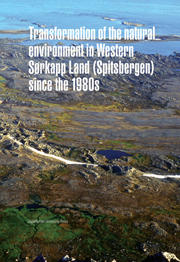Book contents
- Frontmatter
- Contents
- Introduction
- Study area
- Methods and materials
- Components of natural environment
- Environmental and landscape changes
- Climate warming
- Glacial recession
- Transformation of landforms and Quaternary deposits
- Changes of water drainage and networks
- Changes in vegetation
- Conclusions and prognosis for environmental change
- References
- List of enclosures (maps)
- Plate-section
Transformation of landforms and Quaternary deposits
from Environmental and landscape changes
Published online by Cambridge University Press: 05 September 2014
- Frontmatter
- Contents
- Introduction
- Study area
- Methods and materials
- Components of natural environment
- Environmental and landscape changes
- Climate warming
- Glacial recession
- Transformation of landforms and Quaternary deposits
- Changes of water drainage and networks
- Changes in vegetation
- Conclusions and prognosis for environmental change
- References
- List of enclosures (maps)
- Plate-section
Summary
The greatest changes in landforms and Quaternary deposits have occurred due to the glaciers' recession, as described above. New landforms have appeared. Accumulation landforms appeared in the front of glaciers and around glacier tongues in their marginal zones, i.e. on lowlands and valley floors abandoned by glaciers and in their fore-fields situated below the marginal zones (i.e. beyond the former reach of the glaciers, Figs 10–14). Erosion landforms, apart from pro-glacial river incisions (Fig. 15), prevail on the steep slopes of valleys and mountain massifs. Hence, the recession of the upper parts of glaciers results almost exclusively in erosion landforms, and the recession of the lower parts of glaciers leaves both erosion and accumulation landforms behind (with predominance of the latter).
The following new ice-free landforms have been observed: rocky and rock-and-weathering slopes, valley incisions (cut by glacial waters) of different types (gullies, gorges), and roche moutonnées. The decrease in glacier thickness uncovers nunatak slopes from top to bottom. The continuation of this process leads to the joining of nunataks into new mountain ridges or ranges. Once the ice is gone, these erosion landforms undergo mostly non-glacial denudation-erosion changes, especially if they are located on steep slopes and in significantly inclined upper parts of valleys. However, some of them, especially at the foot of the slope and in the lower parts of valleys, are being covered by new deposits, first of all moraine or glacifluvial deposits, but also talus, weathering and fluvial deposits.
- Type
- Chapter
- Information
- Transformation of the Natural Environment in Western Sorkapp Land (Spitsbergen) since the 1980s , pp. 61 - 66Publisher: Jagiellonian University PressPrint publication year: 2011



